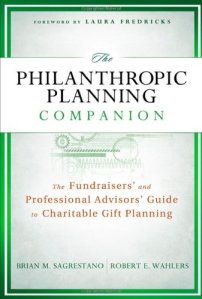Sometimes, nonprofit organizations sue philanthropists over unpaid pledges. This was recently the case with the Kansas City Art Institute. When a charity pursues this type of legal action, it sends shockwaves throughout the nonprofit and philanthropic sectors.
I do believe there are times when a nonprofit can and should sue a donor. However, this should only be done as an absolute last resort. The three instances when a lawsuit might be acceptable are:
1. The donor dies with an outstanding pledge and an heir challenges the will. In that case, the nonprofit might need to sue the estate to establish its claim and collect.
2. The nonprofit incurs real expense based on the donor’s commitment. For example, based on a pledge agreement, the nonprofit breaks-ground on a new building. The nonprofit might need to sue simply to survive.
3. The donor is about to or has entered bankruptcy. Suing the donor would be a way for the nonprofit to establish its claim. (By the way, I suspect that this fear might be what may have triggered the Art Institute case.)
In any case, suing a donor should only be done after careful consideration and only when all other options have been exhausted.
To sue or not sue over unpaid pledges? That is the question. The answer, offered by Brian M. Sagrestano, JD, CFRE and Robert E. Wahlers, MS, CFRE, is: Avoid the problem in the first place!
 Brian and Robert are friends of mine. They are both seasoned, wise development professionals who have served on the national board of the Partnership for Philanthropic Planning. I’m pleased that they have offered to share some of their wisdom below as they introduce us to the concept of “concierge stewardship.”
Brian and Robert are friends of mine. They are both seasoned, wise development professionals who have served on the national board of the Partnership for Philanthropic Planning. I’m pleased that they have offered to share some of their wisdom below as they introduce us to the concept of “concierge stewardship.”
Brian and Robert both generously provided insights and material for my book, Donor-Centered Planned Gift Marketing, for which I won the AFP-Skystone Partners Prize for Research in Fundraising and Philanthropy.
Now, Brian and Robert have written their own book, Philanthropic Planning Companion: The Fundraisers’ and Professional Advisors’ Guide to Charitable Gift Planning, and I’m honored to have been included in their comprehensive volume. The book is part of the AFP/Wiley Fund Development Series.
The official description of the book notes, “For fundraisers and professional advisors alike, The Philanthropic Planning Companion is the one-stop resource you’ll keep by your side to help your donors/clients meet their charitable and personal planning objectives.”
So, do you want to avoid a nightmare at your organization? If so, read on:
The Kansas City Art Institute recently sued Larry and Kristina Dodge for failure to pay $4 million on a $5 million pledge that was to be used to pay for construction of a new building, according to The Kansas City Star.
When the Dodges attempted to defend themselves (rather than hire an attorney they indicated that they could not afford), they made procedural errors and a default judgment was entered against them for the full $4 million due on the pledge. According to The Star, the Dodges made three payments on their pledge before their financial situation was impacted by the Great Recession, limiting their ability to fulfill the commitment.
In the article, Larry Dodge is quoted, indicating that he and his wife were in negotiation with the Institute to come up with a payment plan when it unexpectedly filed suit to collect on the pledge.
Regardless of the outcome, the reputations of both the Dodges and the Institute are forever harmed. Prospective donors will think twice before making a major commitment to a charity that would sue them to collect on a pledge. Meantime, the Dodges reputation, despite their many years of generous philanthropy, will be forever tarnished.
We cannot judge the merits of the Art Institute’s action or the ability of the Dodges to pay on their pledge, as we are not privy to all of the facts of the case. However, it raises a much larger issue about charities and pledges.
When accepting a naming gift, the charity takes on real reputational risk should the donor have financial or criminal difficulties in the future. It also reminds us that we need to take the same care in stewarding a donor as we do in cultivating a donor to maintain a proper relationship. A donor-centered approach whereby the donor’s issues and needs are addressed would seem to have helped in this case since the donor was apparently open to a new pledge payment schedule, but needed some flexibility given the circumstances.
By remembering that we can partner with our donors in reaching our common goals, we can focus on the mission of our organization together and seek solutions that work for all concerned. In Chapter Six of our book, The Philanthropic Planning Companion, we introduce the concept of “concierge stewardship” as the best way to ensure that a donor-centered approach carries through to an ongoing relationship with a charity’s most significant donors. Concierge stewardship is the one-on-one support, help, and affirmation that charities and advisors continue to provide to donors and their families across generations as they implement the donors’ philanthropic legacy.
Stories like this Art Institute story highlight the need for strong and effective gift acceptance policies, gift recognition policies and comprehensive gift agreements. Unfortunately, most charities are so worried about losing larger gifts that they:
1. do not put effective policies and agreements into place,
2. do not follow the organization’s policies for larger gifts,
3. never update the policies so they are out of date when needed.
What these charities do not realize is that every large gift ends up being a negotiation. By putting in place strong policies that are followed regularly, it gives the charity a much stronger line of defense when discussing what it will and will not do when accepting a transformational gift.
Chapter 14 of the Companion discusses policies, procedures and gift agreements, including samples. When approaching gift agreements, we suggest circumstances when either a binding or non-binding gift agreement is necessary, what are the core components of the agreement, when or if gift agreement terms should be enforced, and how the agreement should deal with restricted funds.
In the case of the Art Institute, a public airing of this dispute could have been avoided by using arbitration while a clause allowing for the removal of a name from a building due to reputational risk would have allowed the Art Institute to approach another donor to replace this funding. A well-put together gift agreement anticipates potential pitfalls and provides contingencies to avoid them.
We often hear that charities cannot afford to put effective policies, procedures and agreements in place. That legal counsel costs too much and the risks are low. However, as the Art Institute is learning, a public airing of its grievance against a donor can be just as bad, or worse than not receiving the payments on a pledge.
Charities are far better served by investing a fairly modest amount to create good policies and template agreements up front. They can then maintain them at a very low cost going forward. I’m sure the Art Institute, if they could do it again, would handle this situation differently.
The best time to put your policies in place is before you have an incident. As you put together your plan for 2013, make sure that updating your policies, procedures and gift agreements has a place in the plan. Then, you’ll be able to avoid many problems all together.
That’s what Brian Sagrestano, Robert Wahlers, and Michael Rosen say… What do you say?
UPDATE (April 7, 2013): Brian Sagrestano and Robert Wahlers have won the 2013 AFP-Skystone Research Prize for their work on their book. This is only the fourth planned giving book to be honored in this way. Congratulations!
[Publisher’s Note: From time-to-time, I will invite an outstanding, published book author to write a guest post. If you’d like to learn about how to be a guest blogger, click on the “Authors” tab above.]








